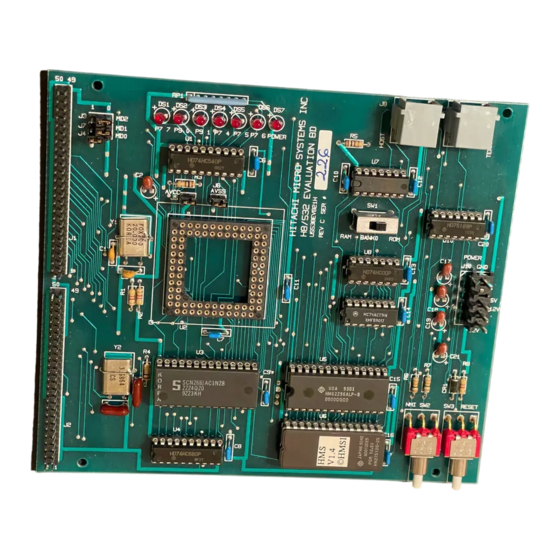
Hitachi H8/500 Series Manuals
Manuals and User Guides for Hitachi H8/500 Series. We have 1 Hitachi H8/500 Series manual available for free PDF download: Hardware Manual
Hitachi H8/500 Series Hardware Manual (459 pages)
Brand: Hitachi
|
Category: Computer Hardware
|
Size: 2.16 MB
Table of Contents
-
Features22
-
Overview43
-
Overview50
-
Features50
-
Data Formats60
-
Instructions63
-
Overview69
-
Minimum Mode81
-
Maximum Mode82
-
Overview82
-
CPU States88
-
Overview88
-
Reset State96
-
Overview100
-
Reset104
-
Overview104
-
Reset Sequence104
-
Reset Vector105
-
Address Error108
-
Trace109
-
Interrupts109
-
Overview116
-
Features116
-
Block Diagram117
-
Interrupt Types118
-
Overview131
-
Features131
-
Block Diagram131
-
DTC Vector Table138
-
Example143
-
Overview145
-
Features145
-
Block Diagram146
-
Wait Modes148
-
Pin Wait Mode149
-
Pin Wait Mode150
-
Overview152
-
Block Diagram152
-
Overview156
-
Port 1159
-
Overview159
-
Port 1 Registers159
-
Pin Functions159
-
And P1160
-
Port 2166
-
Port 2 Registers166
-
Port 3168
-
Overview168
-
Port 3 Registers169
-
Port 4172
-
Port 4 Registers172
-
Overview174
-
Port 5 Registers175
-
Overview180
-
Port 6 Registers181
-
Port 7184
-
Overview184
-
Port 7 Registers185
-
Pin Functions186
-
Port 8189
-
Overview189
-
Port 8 Registers189
-
Port 9190
-
Overview190
-
Port 9 Registers190
-
Pin Functions193
-
Overview194
-
Features194
-
Block Diagram195
-
CPU Interface205
-
Operation207
-
Overview223
-
Features223
-
Block Diagram224
-
Operation230
-
Overview242
-
Features242
-
Block Diagram242
-
Operation247
-
PWM Timing248
-
Overview250
-
Features250
-
Block Diagram251
-
Operation255
-
Overview260
-
Features260
-
Block Diagram261
-
SCI Registers262
-
Operation274
-
Overview274
-
Synchronous Mode279
-
Receive Errors279
-
SCI Interrupts284
-
Overview287
-
Features287
-
Block Diagram288
-
Input Pins289
-
A/D Input Pins289
-
A/D Registers289
-
CPU Interface293
-
Operation294
-
Single Mode295
-
Scan Mode298
-
Section 16 RAM304
-
Overview304
-
Block Diagram304
-
Operation305
-
Section 17 ROM307
-
Overview307
-
Block Diagram307
-
PROM Modes308
-
PROM Mode Setup308
-
Socket Adapter309
-
Programming311
-
Notes on Writing314
-
Erasing of Data316
-
Overview318
-
Sleep Mode319
-
Overview325
-
Bus Timing331
-
Bus Timing335
-
Clock Timing340
-
E Clock Timing340
-
I/O Port Timing342
-
Instruction Set346
-
Port 2 Port Read422
-
Port 3 Port Read423
-
Port 4 Port Read424
-
Port 5 Port Read425
-
Port 6 Port Read426
-
And P9433
-
And P9434
Advertisement
Advertisement
